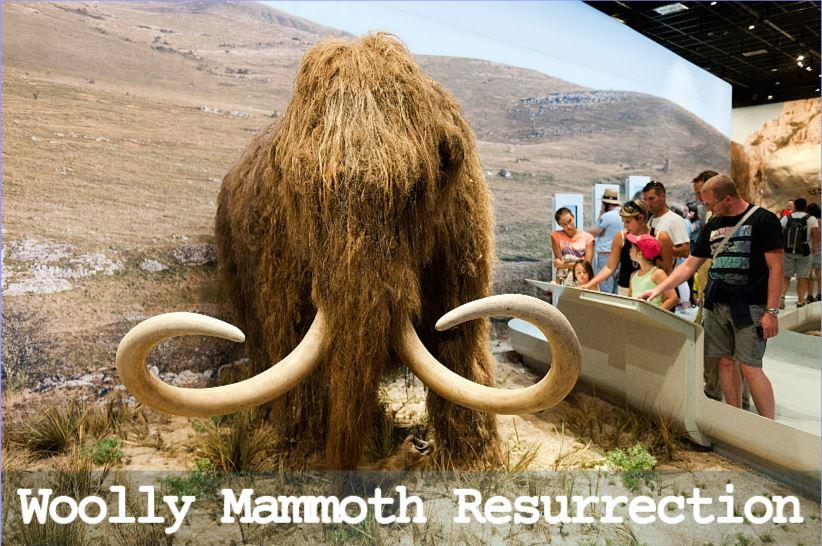Table of Contents
ToggleRESURRECTION OF THE WOOLLY MAMMOTH is possible?
Introduction
Have you heard about the latest scientific endeavor to bring back the extinct woolly mammoth? A team of scientists, led by George Church of Harvard Medical School, has received $15 million in funding for this “de-extinction” project. The plan is to use genetic manipulation technology to splice together thousands of woolly mammoth genes, preserved by the arctic cold, with genes of Asian elephants to create a hybrid species with woolly-mammoth characteristics. Experts suggest that resurrecting the woolly mammoth could help reduce the rate of carbon release from arctic soil and control global warming, thanks to their grazing activity.
De-Extinction: A Reality Check
The idea of de-extinction is not new – it was popularized by Hollywood in Jurassic Park. It’s easy to imagine the worst-case scenarios, such as a rampaging neo-mammoth attacking a tourist bus. Do we need to be concerned about any subtler issues though?
The Reality of Woolly Mammoth Resurrection
Currently, a true resurrection of the woolly mammoth isn’t possible. The last woolly mammoths died out nearly 4,000 years ago and while arctic conditions preserved large amounts of their genetic material, it is far too degraded for direct cloning. Instead, the preserved genetic material would be spliced together with Asian elephant genes to produce a hybridized animal.
Creating a Hybrid Animal: The Mammophant
This hybrid animal, referred to as a “mammophant,” would look and behave like the woolly mammoth, but it would be something entirely new. Some differences between the original woolly mammoths and mammophants would be deliberate – for example, the new specimens would lack tusks to minimize the risk of poaching. This is a significant change, considering that woolly mammoth tusks have been found in various locations around the world, including the East River.

Critics’ Perspective
Critics point out that there is no proof that mammophant herds would actually have any effect on arctic ecosystems or climate change. In fact, mammoths may have gone extinct because climate change eliminated their habitat and ecosystems. Mammophants might immediately become an endangered species in a world that now lacks the environments in which woolly mammoths once thrived.
The Genetic Challenges Ahead
Genetic manipulation experiments with other extinct mammals suggest that we’re still a long way from achieving a woolly mammoth resurrection. The only real way to know how a gene shapes an animal’s body or behavior is to see it in action.
Conclusion
In short, resurrecting the woolly mammoth is a difficult and uncertain project at best. It raises complex practical and ethical issues and may not even be possible. But imagine seeing a woolly mammoth – or even a mammophant – living in the wild. That would certainly be awesome!
Also read:

FAQ
1. What is the process of creating a hybrid animal like the “mammophant”?
Ans: The process of creating a hybrid animal like the “mammophant” involves using gene-editing technology to splice together thousands of woolly mammoth genes, preserved by the arctic cold, with genes of Asian elephants to create a hybrid species with woolly-mammoth characteristics.
2. How long will it take to create a “mammophant”?
Ans: The goal is to have the first calves of the “mammophant” in the next four to six years.
3. What are the potential benefits of bringing back the woolly mammoth?
Ans: The potential benefits of bringing back the woolly mammoth include restoring the fragile Arctic tundra ecosystem, combating the climate crisis, and preserving the endangered Asian elephant, to whom the woolly mammoth is most closely related.
4. What are the potential risks and challenges associated with bringing back the woolly mammoth?
Ans: Some potential risks and challenges associated with bringing back the woolly mammoth include ethical issues, such as creating a hybrid animal that might immediately become an endangered species in a world that now lacks the environments in which the woolly mammoths once thrived.
5. How will the “mammophant” be different from the original woolly mammoth?
Ans: The “mammophant” will be different from the original woolly mammoth in that it will be a hybrid species created through genetic engineering, and some of its characteristics will be deliberately altered, such as lacking tusks to minimize the risk of poachers killing them for ivory.
6. How will the “mammophant” be integrated into its natural habitat?
Ans: It is not clear how the “mammophant” will be integrated into its natural habitat, but proponents say that bringing back the mammoth in an altered form could help restore the fragile Arctic tundra ecosystem.
7. What are the ethical considerations surrounding the resurrection of extinct species?
Ans: Some ethical considerations surrounding the resurrection of extinct species include creating a hybrid animal that might immediately become an endangered species in a world that now lacks the environments in which the woolly mammoths once thrived, as well as other complex practical and ethical issues.
8. How will the “mammophant” be protected from poaching and other threats?
Ans: It is not clear how the “mammophant” will be protected from poaching and other threats, but one measure that has been proposed is to create specimens that lack tusks to minimize the risk of poachers killing them for ivory.


I’m gone to say to my little brother, that he should also go to see this blog on regular
basis to take updated from newest information.
I was able to find good advice from your blog articles.
We stumbled over here coming from a different web page and thought I might as
well check things out. I like what I see so now i’m following
you. Look forward to finding out about your web page again.
Hi to all, how is all, I think every one is getting more from this
website, and your views are good designed for new visitors.
When someone writes an paragraph he/she keeps the
plan of a user in his/her brain that how a
user can know it. Therefore that’s why this article is perfect.
Thanks!
Thank you and visit again…
Greetings! This is my 1st comment here so I just wanted to
give a quick shout out and say I truly enjoy reading through your posts.
Can you suggest any other blogs/websites/forums that cover
the same topics? Appreciate it!
I do accept as true with all the ideas you’ve introduced
in your post. They’re very convincing and can definitely work.
Still, the posts are too brief for novices. Could
you please extend them a little from subsequent time?
Thanks for the post.
Hi there to all, the contents existing at this website are truly amazing for people experience, well, keep up the nice work fellows.
Hello! Do you use Twitter? I’d like to follow you if that would be ok.
I’m definitely enjoying your blog and look forward to new posts.
Very good post. I will be facing some of these issues as well..
My coder is trying to persuade me to move to .net from PHP.
I have always disliked the idea because of the expenses.
But he’s tryiong none the less. I’ve been using WordPress on several websites for about a year and am anxious
about switching to another platform. I have heard excellent things about blogengine.net.
Is there a way I can import all my wordpress content into it?
Any kind of help would be greatly appreciated!